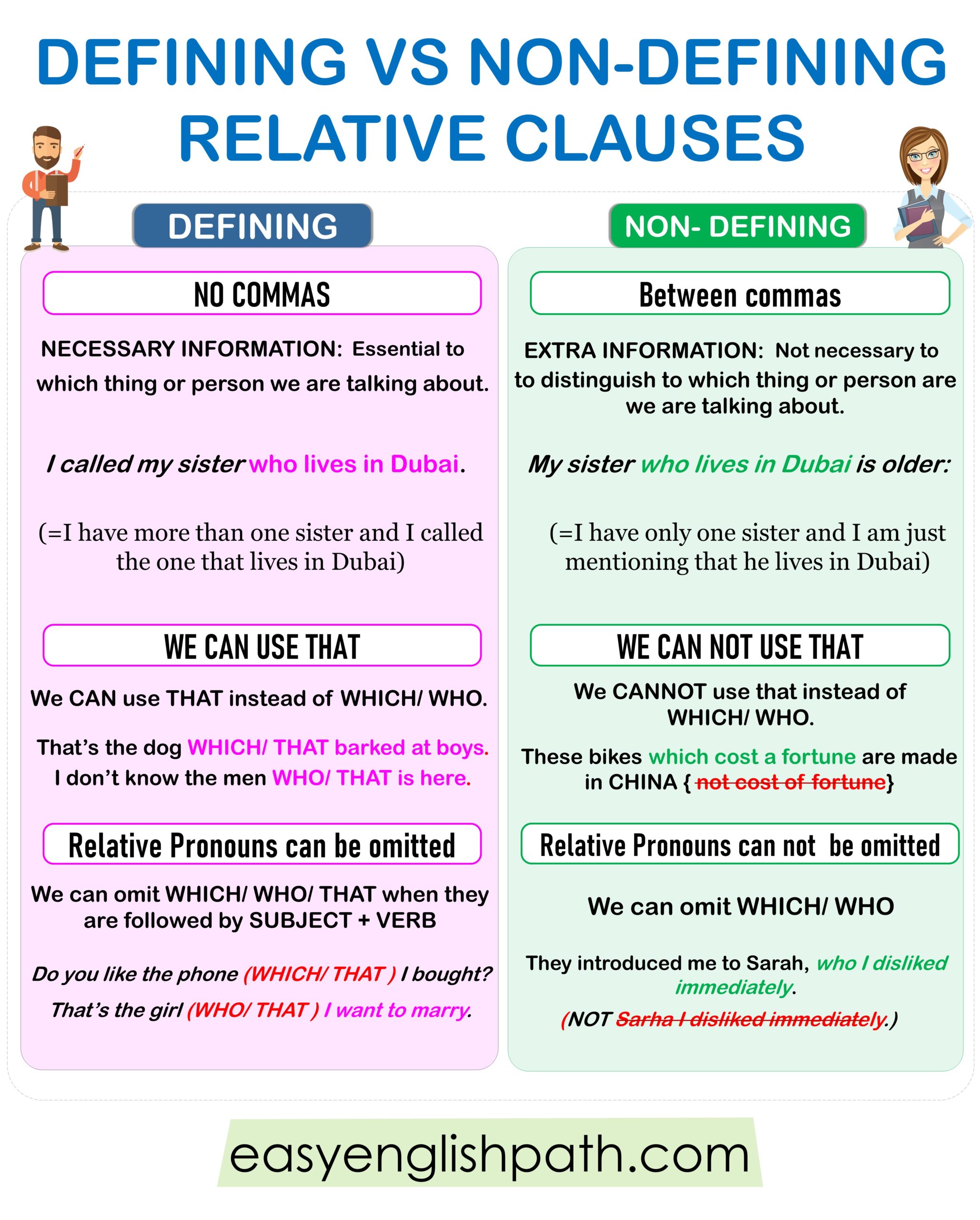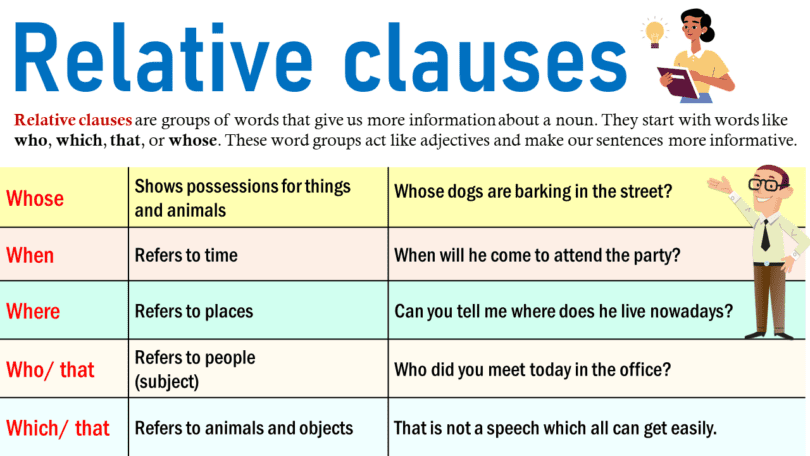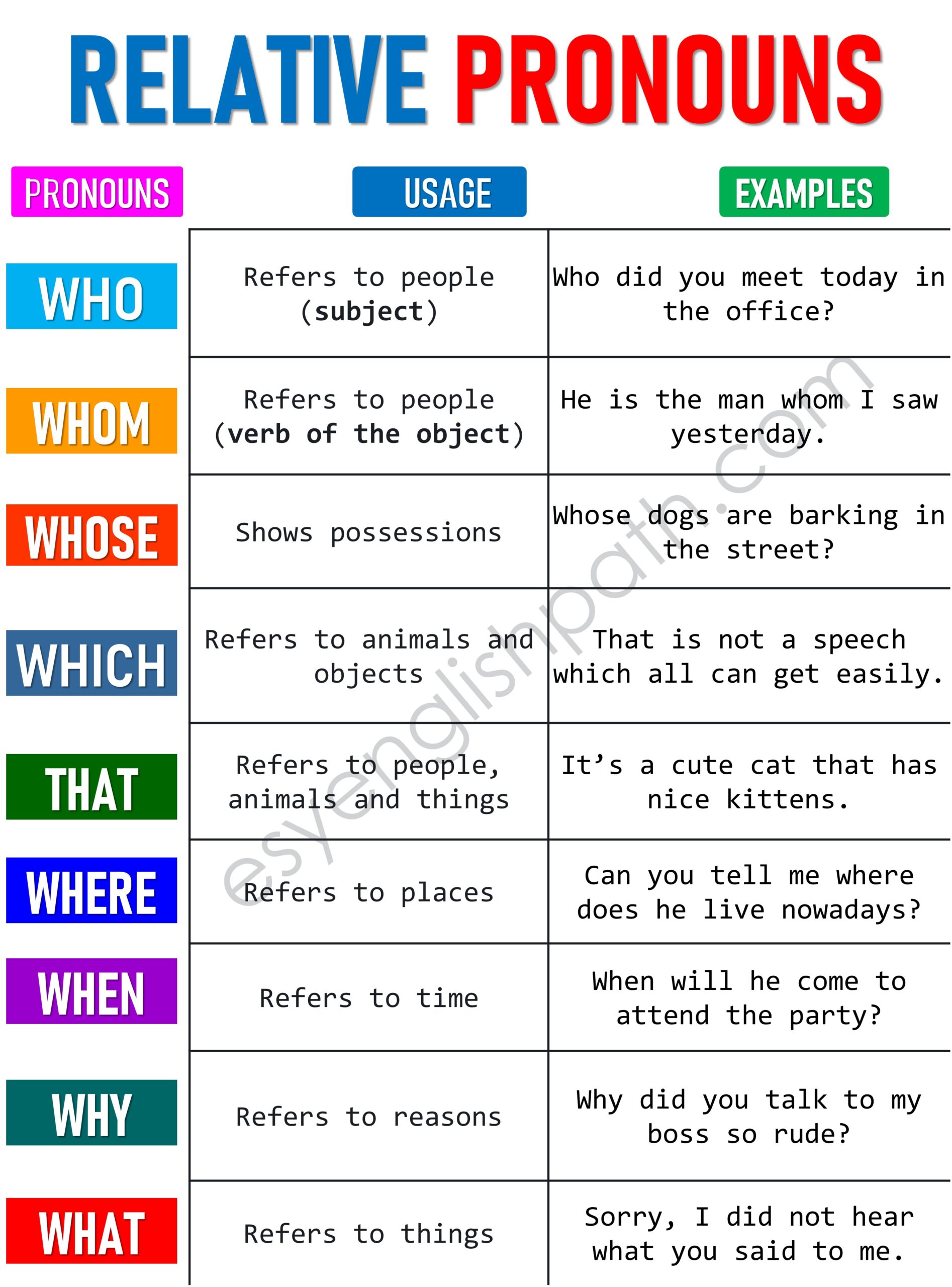Relative clauses are parts of a sentence that add more information about something mentioned before. This post focuses on active relative clauses, which are important for making sentences clear.
They usually start with words like who, which that, and whose.’ These clauses help us specify exactly what or who we are talking about, avoiding confusion. This blog post will help English learners understand and use these Relative clauses in grammar confidently, improving their language skills.
Relative Pronouns Words:
| Relative Clause Type | Subject | Object | Possessive |
|---|---|---|---|
| Pronoun | who | who/whom | whose |
| Object | – | which | whose |
| Determiner | that | that | – |
What Are Relative Clauses?
Relative clauses are groups of words that give us more information about a noun. They start with words like who, which, that, or whose. These word groups act like adjectives and make our sentences more informative.
- The woman who lives next door is a teacher.
- John’s car, which is red, is parked in the driveway.
- The dog that barks loudly is my neighbor’s pet.
Different Types of Relative Clauses
There are two main types: restrictive (defining) and non-restrictive (non-defining).
1. Restrictive (Defining) Relative Clauses
These clauses are used to provide important information about the noun. You can’t take them out of the sentence without changing what it means.
- The book that I borrowed is on the table.
- The man who is wearing a hat is my uncle.
- The cat that chased the mouse is fast.
2. Non-Restrictive (Non-Defining) Relative Clauses
Non-restrictive clauses are used to give extra information in a sentence. They’re set apart with commas.
- My sister’s car, which she bought last year, is in the garage.
- The dog, who is very friendly, loves to play in the park.
- My sister, who lives in Paris, is coming to visit.
More About Defining & Non-Defining Relative Clauses
Defining Relative Clause
Defining relative clauses (restrictive relative clauses) provide essential information about a noun, helping to identify or specify it. Without them, the sentence may be unclear or incomplete. They are closely linked to the main sentence and are not separated by commas.
- The book that I borrowed is on the table.
- The cat that chased the mouse is fast.
- The book that is on the table is mine.
Non-Defining Relative Clause
Non-defining relative clauses (non-restrictive relative clauses) provide extra, non-essential information about a noun. They add details that are not crucial to the sentence’s meaning. These clauses are set off by commas and can be removed without affecting the core message.
- My sister, who is an excellent musician, is performing tonight.
- The building, which was built in the 19th century, is a historic landmark
- The car, which belongs to my neighbor, is parked in front of our house.
Differences Between Defining and Non-Defining Relative Clauses
| Aspect | Defining Relative Clauses | Non-Defining Relative Clauses |
|---|---|---|
| Essential vs. Non-Essential Information | Provides essential information to identify the noun. | Adds extra, non-essential details about the noun. |
| Punctuation | No commas; tightly connected to the sentence. | Set off by commas; separate from the main sentence. |
| Example Sentence | The car that I bought is red. | My car, which I bought last week, is red. |

Relative Pronouns
Relative clauses start with relative pronouns. The choice depends on the noun being described. The common ones are who, which, that, and whose.
- The person who helped me was my teacher.
- The book which I read was fantastic.
- The car that I drive is green.
- The man whose wallet was lost has arrived.
Combining Relative Clauses
Sometimes, we have sentences with more than one relative clause. You need to understand how they work together.
- The house, which is painted blue, sits on the corner.
- The woman who lives next door is a doctor.
- The book that you lent me is fascinating.
Using Prepositions with Relative Clauses
1. Location and Prepositions:
Prepositions often play a crucial role in indicating the location or place where something happens. When you use a relative clause to describe a noun’s location, the preposition in question helps provide that context.
- The city in which I was born is beautiful.
- The park by which we used to play soccer:
- The restaurant next to which they built a new mall: “
2. Time and Prepositions:
Prepositions can also be used to indicate time-related information. In conjunction with relative clauses, they specify when an event occurred or when a particular noun is relevant.
- The day on which we met was memorable.
- The party during which we celebrated her birthday:
- The vacation after which we returned home:
3. Method or Basis:
Prepositions like on, by, and with are often used to describe the method, basis, or means by which something is done or the foundation of an idea or action.
- The report on which I based my decision was comprehensive.
- The criteria on which we evaluate job applicants:
- The principles according to which we operate our business:
Relative Clauses vs. Noun Clauses
| Aspect | Relative Clauses | Noun Clauses |
|---|---|---|
| Function | Modify a noun by giving more information about it. | Act as a noun (subject, object, or complement). |
| Introduced By | Relative pronouns (who, whom, whose, which, that). | Conjunctions (that, whether, if) or question words. |
| Can Be Removed? | Defining clauses: No; Non-defining clauses: Yes. | No, as they function as a key part of the sentence. |
| Example | The book that I borrowed was interesting. | I don’t know where she went. |
Common Prepositions and Their Uses
Several prepositions are frequently used in conjunction with relative clauses to convey various types of information.
| Preposition | Usage | Example |
|---|---|---|
| In | Indicates location or the place where something occurs. | She is in the room. |
| On | Refers to a surface, basis, or specific time. | The book is on the table. |
| At | Indicates a specific location or particular time. | We met at 5 PM. |
| By | Shows means, method, or the agent responsible. | The song was written by her. |
| With | Indicates association, possession, or accompaniment. | She went with her friends. |
| For | Demonstrates purpose, reason, or goal. | This gift is for you. |
| From | Shows origin, source, or separation. | He is from Canada. |
| Of | Indicates possession, relationships, or material. | The legs of the chair are broken. |
| About | Refers to a topic or subject. | We talked about the movie. |
| To | Indicates direction, recipient, or purpose. | He gave the book to me. |
| Into | Shows movement towards the inside of something. | She walked into the room. |
| Between | Refers to something in the middle of two things. | The ball is between the chairs. |
| Among | Indicates being part of a larger group. | She was among the crowd. |
You May Also Like






